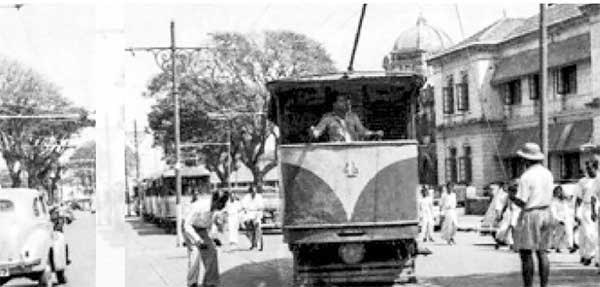Colombo’s trams-By Dilshan Nadeera

A historical vignette
The Colombo Electric Lighting and Tramways Co Ltd was a British company represented in Ceylon by Boustead Brothers. The Tramways were ready for operations by 1899/1900. This company owned and operated the Pettah Power Station at Saunders Place which supplied the 110 volts DC power to propel the trams.
The tramcar Depot was next to the Gas Works adjoining the Pettah Power Station. From the depot the tramcars entered and exited through Gasworks Street on one side joining with Main Street, and on the other with Norris Road (today Olcott Mawatha). Turning right the route went past the Pettah Railway Station, New Fort Railway Station and Old Fort Railway Station. Lower Chatham Street alongside the Central Telegraph Office and the Chamber Of Commerce, took a right turn on to York Street near the Registrar General’s Office, passed Bristol Hotel, Millers/Cargills, Colombo Apothecaries, National Bank, the Victoria Arcade, the P&O Building and terminated near the Grand Oriental Hotel which served as the halt for the Colombo Harbour.
From Prince Street Fort, the Tramway went past the Times Building, Walker Sons, Gaffoor’s Buiding, Chalmers’ Granaries, near the Khan Clocktower and on the side of the Consistory (Kerkopf) Main Street. Near the Old Town Hall there was a choice of turning right to enter Gaswork Street along Edinburgh Market or turn left to enter Dam Street, continue on New Moor Street, continue to Messenger Street, cross Armour Street, join Grandpass Road, join St. Josephs Street and on to Nagalagam Street to the terminus near the old Grandpass Market at the corner with Ferguson Road.
Coming out of the Depot, at Norris Road taking a left turn the line was laid past the Mounted Police Division, past the old Colombo Railway Station, took a left turn near the Colombo Technical College took a right turn on to Central Road, continued past the old Railway Workshops, passing the Elphinstone to Maradana Junction, This road was known as Parana Veediya in days gone by, passed Punchi Borella to the terminus at Borella.
Due to A. E Goonesinha’s tramcar strike (1929) the company lost interest in expanding the network or maintaining the system. The decrepit system was sold to the Colombo Municipal Council in 1943 and their Tramways Dept operated the system until 1960. About 1953 it was decided to phase out the trams and replace them with Electric Trolley Buses. After the tramcar strike in 1929, the Colombo Municipal Council took over operations of the electric tram system on August 31, 1944.The tram network were eventually scrapped in 1960.
The Colombo Municipal Council closed the service on June 30, 1960. Tramcars were involved in many accidents. Accidents took place due to the wires which had fallen on tramcars. A Commission was appointed by the Governor to inquire into these accidents. The report of the Commission was submitted to the Municipality after the close of the year. This report has been referred to a special committee of the Council. Many accidents were reported during this time. Some cases were due to passengers jumping on and off the cars whilst in motion. There were occasional complaints of public inconvenience owing to overcrowding of the tramcars. Tram pathways are still visible in certain places.
Many Websites show incorrect captions of pictures with other trams of the region. A popular photo is of a colonial looking building with a tramcar No 70 (really a Bombay tram) in front of it which is touted as a Colombo tram; this cannot be; Colombo never had more than 56 tramcars. The earliest tram cars were of a ‘toast rack’ style, skeletal looking and of a more open design, later some were given a cladding to match the styling of the time.
The tramcars were sold by the CMC auction at 100 Rupees per car. Most were purchased by A. Y. S. Gnanam who had already made a fortune with War Surplus steel and other metals..
There were two Burgher gentlemen who were Inspectors, they were known for their ability to swing in and out of moving trams. One was tall and nicknamed ’Anamalu’, the other was plump and nicknamed ‘Kolikuttu’ (de Bruin). His house exists in Punchi Borella, though the current ‘occupants’ have no connection with the de Bruins. The administration office of Tramways Ltd had been at Union Place.
Cedric Boustead’s residence is now the Colombo Swimming Club.
The track gauge was three feet six inches. There are still tram lines visible near the Old Town Hall and on Grandpass Road. The only Tram Car halt sign board was found at the end of St. Josephs Street.
On June 16, 1899 at 10pm, a tramcar traveling along Maradana Road (now Gnanaratha Pradeepa Mawatha) collided with a pony cart travelling from Regent Street to Jail Road (now E W Perera Mawatha, and Ananda Rajakaruna Mawatha) causing injury to the two cart riders and pony, and damage to the cart and harness.
Credits to History of Ceylon Web Page and Wikipedia , photo credits to The Archives .








No Comments